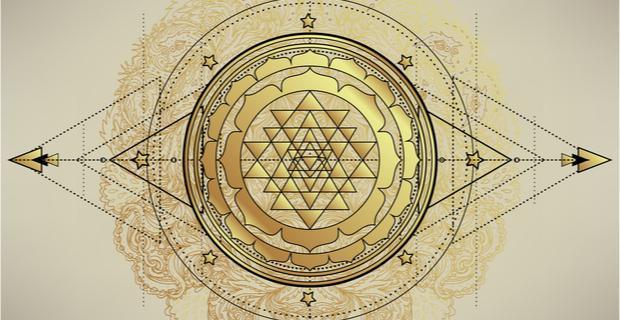What is Yantra?
What is Yantra?
Yantra Meditation
What’s the difference between mantra and yantra? It’s the difference between mind and body. A mantra is a word or phrase you repeat in the mind to concentrate on, a yantra is a physical symbol that you use to meditate to engage the mind in a withdrawal of consciousness. A yantra is a visual instrument that helps you center, simply put.
Yantras are from the Hindu religion, but the concept of visual meditation is not unique to Hinduism. Mandalas in the Buddhist tradition concentrate the mind, and Labyrinths have been used by Native American, Celtic, Greek and Mayan cultures for the same goal. A yantra is typically made by very precise procedure, which comes straight from the Vedas, or yogic scriptures.
A yantra is a symbolic representation of a deity. When an individual can step outside of their critical mind, a correctly made yantra is known to become the physical body of that deity. It is believed that no image of a deity is as powerful as a yantra because instead of illustrating a representation, it uses sacred geometry, almost like a photo of a person cannot be as precise as a strand of that person’s DNA. If a yantra symbolises an aspect of the Goddess, it is called a Shakta Yantra. It is fascinating to mention that the gods Vishnu and Shiva might be represented in a yantra, but their form is the same as that of a goddess, with only differences in colour. When combined with a specific mantra, a yantra invokes in physical form the presence of a certain deity’s prana (or life force).
The visual impact of a yantra is only one part of its power. Making a yantra is a sacred artistic process. If you believe singing a mantra is more active and engaging than painting a yantra, consider that a yantra works on the skills of accuracy, patience, discipline and precision. It stimulates the right hemisphere of the brain, which is non-verbal. When combining yantra and mantra, you balance the two hemispheres of the brain.
Yantras may be worn on the body as an amulet and when done so are believed to have magical powers. They might as well be built to represent astrological alignments that are particularly favorable and can be made out of precious gemstones and metal alloys.
Many symbols are commonly found in yantras. A bindu is the most basic form, a dot, and it represents the beginning point of all creation. Lotus flowers represent the chakras. A Shatkona (known in the west as a Star of David), with its masculine up-turned triangle with a feminine down-turned triangle symbolizing the union of masculine and feminine, which brings all life. There is a grammar within these symbols all their own. An upward triangle also represents turning attention up to the heavens, while the downward triangle means attention to matters in this world. Thus the Shatkona represents that life (the union of masculine and feminine) happens when we harmonise the spiritual with the material. A swastika represents good luck and prosperity, but when you reverse the direction it points (as the Nazis did), it represents chaos and destruction. A five-pointed star is used to represent Earth. Yantra symbols are also associated with the elements. A circle or a horizontal line is associated with the water element, a square with the earth, a triangle or a vertical line with fire, diagonal lines with air, a point with ether.
To meditate on a yantra, gaze at it steadily. Try not to blink, slow down your breath and have no preconceived notions about what is to happen. Concentrate on the center of the image. After a few minutes, shut your eyes and continue meditating on the form of the yantra as seen in your minds eyes. Keep your focus steady. Relax the mind as long as you can on the picture. It may only be a few seconds at first. See what happens.
Putting yantras in your home, as well as other types of sacred geometry, can help you create a strong sacred energy in your individual space and invoke the powerful energies of Goddesses in your home. Spirit Voyage’s Interfaith Yantra Poster is an example of a modern adaptation to the traditional yantra that helps bring a feeling of unity and oneness among all mankind. Those who know the teachings of Masaru Emoto and the effects of words and symbols of water will like Spirit Voyage’s Stainless Steel Water bottles, which have a wonderful yantra energizing the water within. To make the yantra a little more personal and wear it on your body, check out our organic Spirit Voyage tshirt (available for both men and women). We have even found a yantra-tastic yoga mat!
Be the first to post a message!
